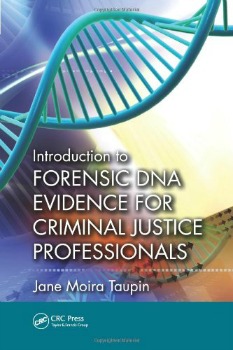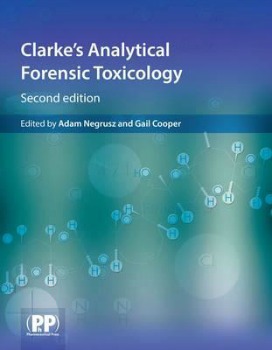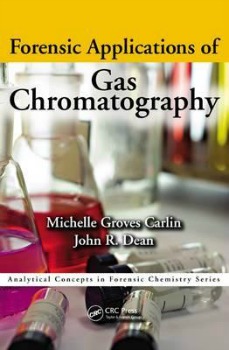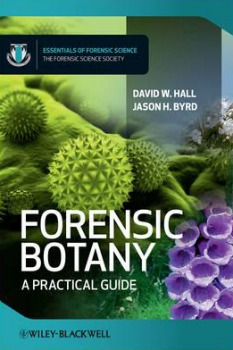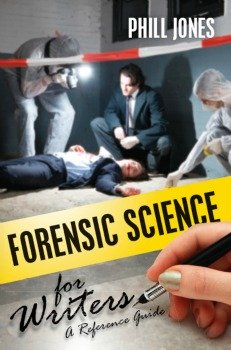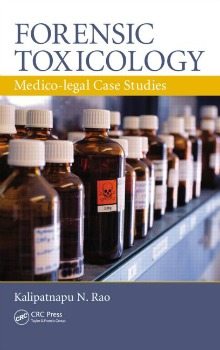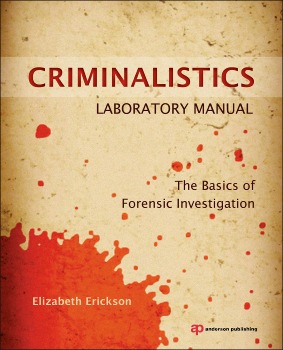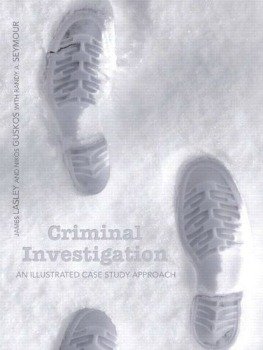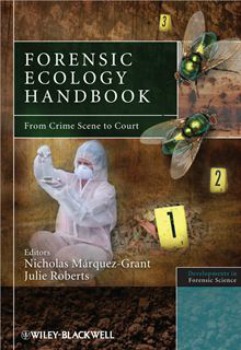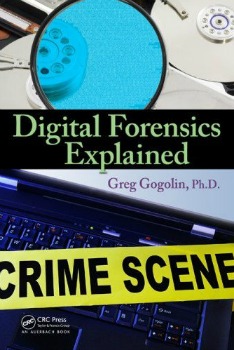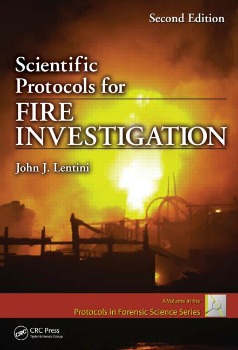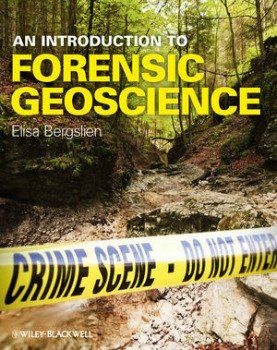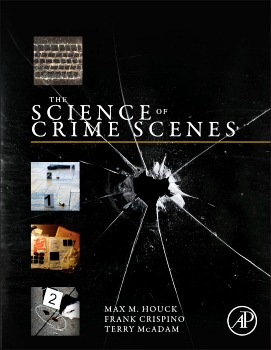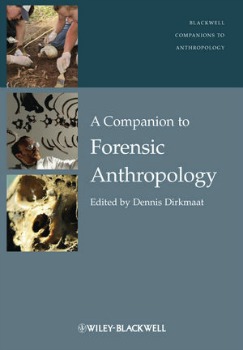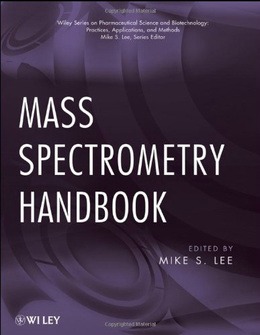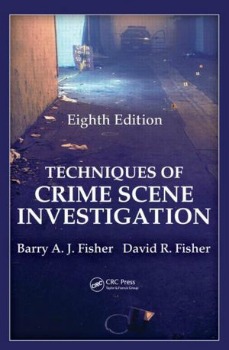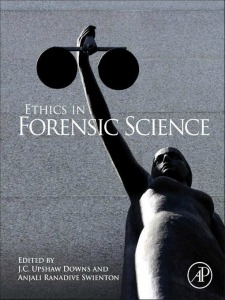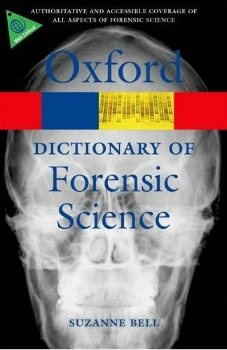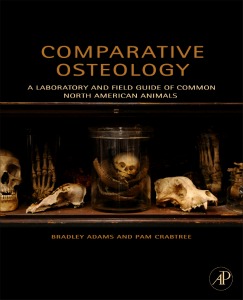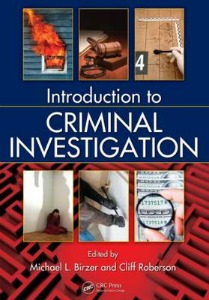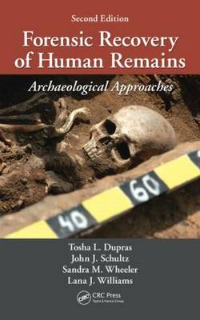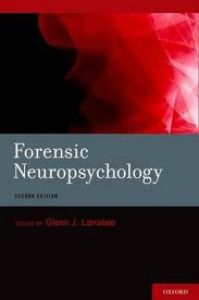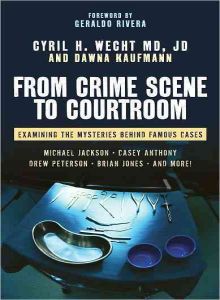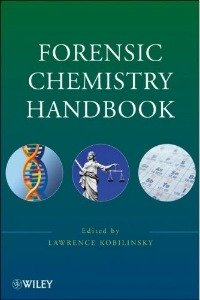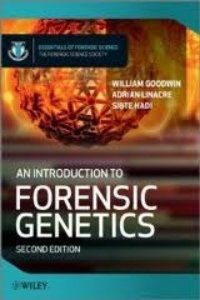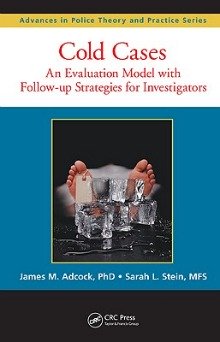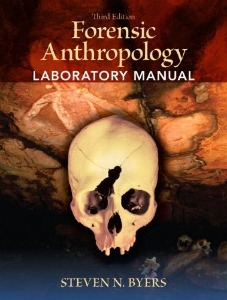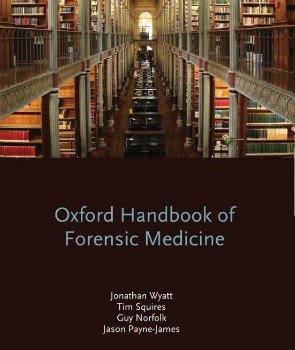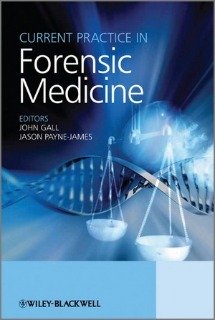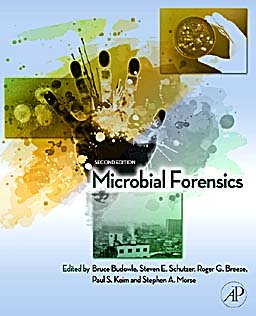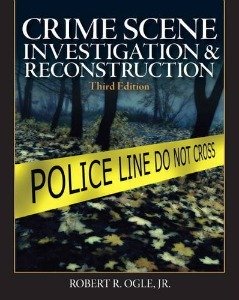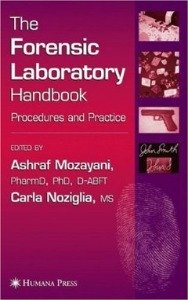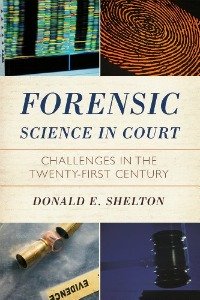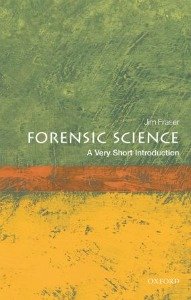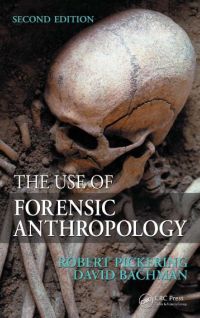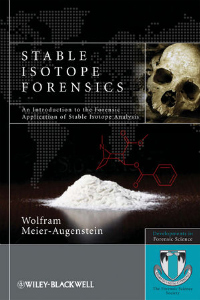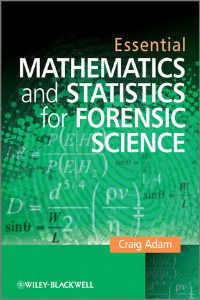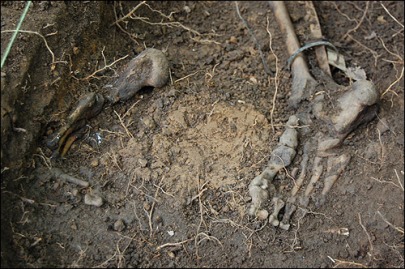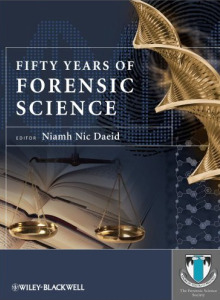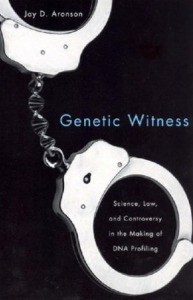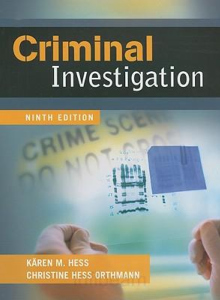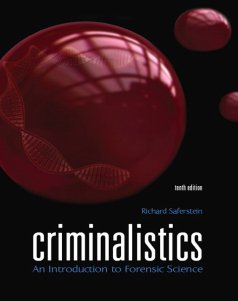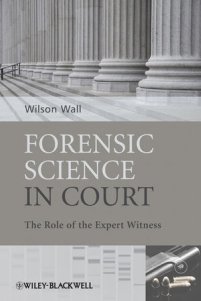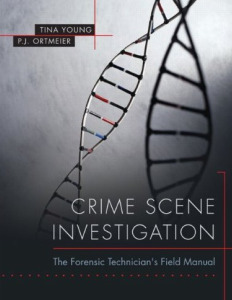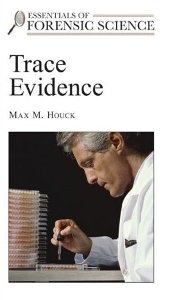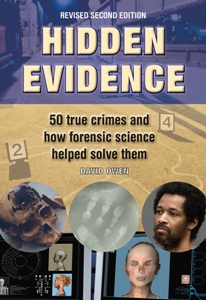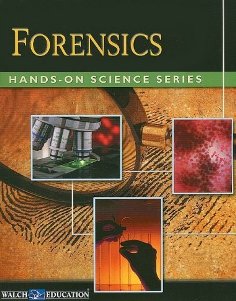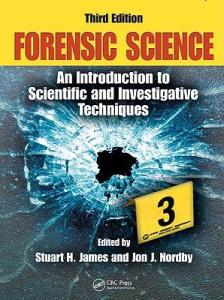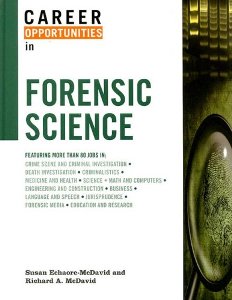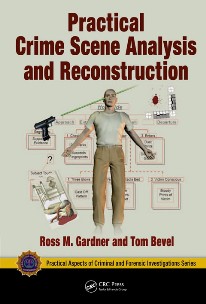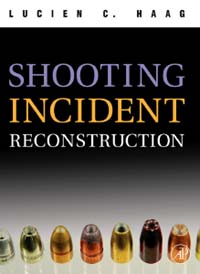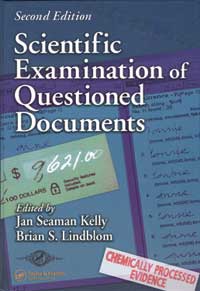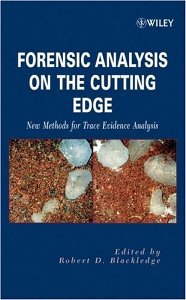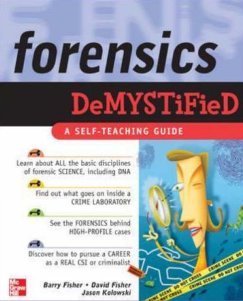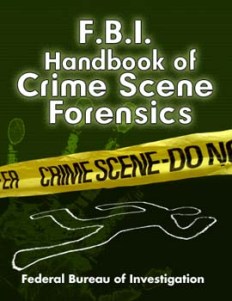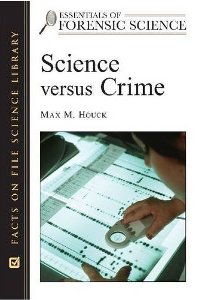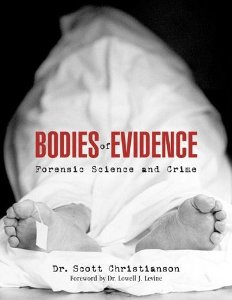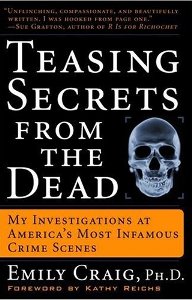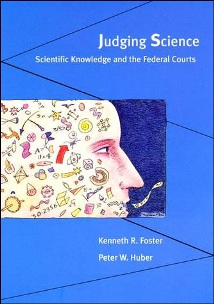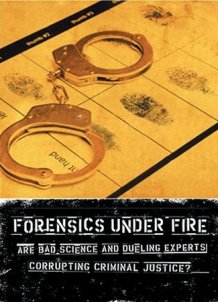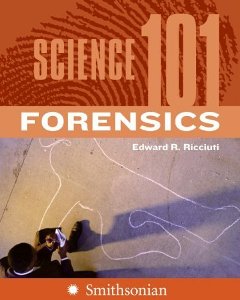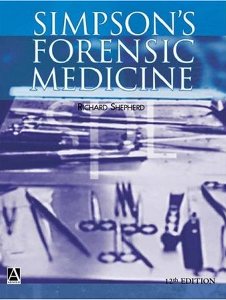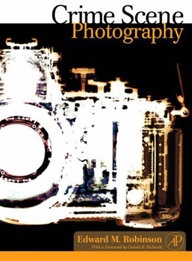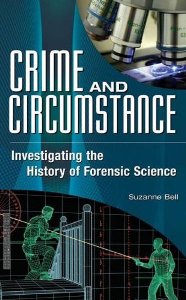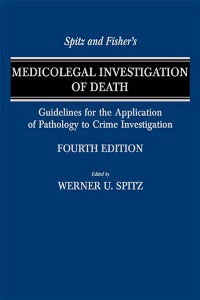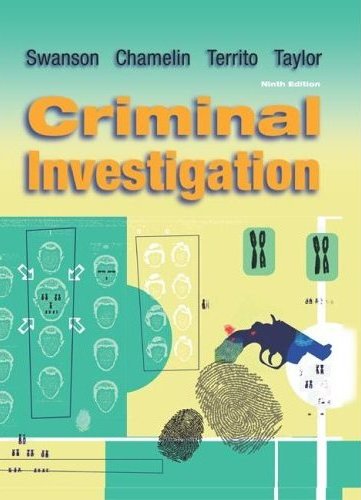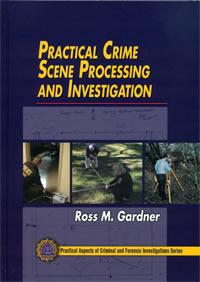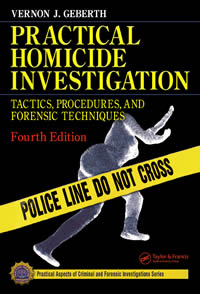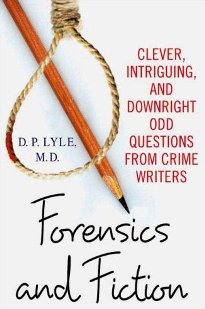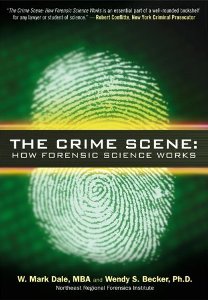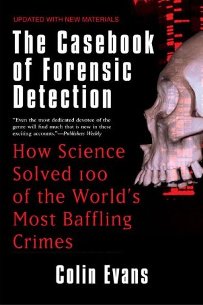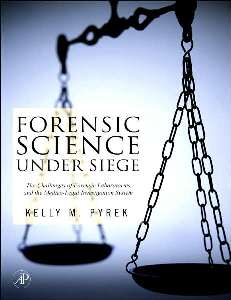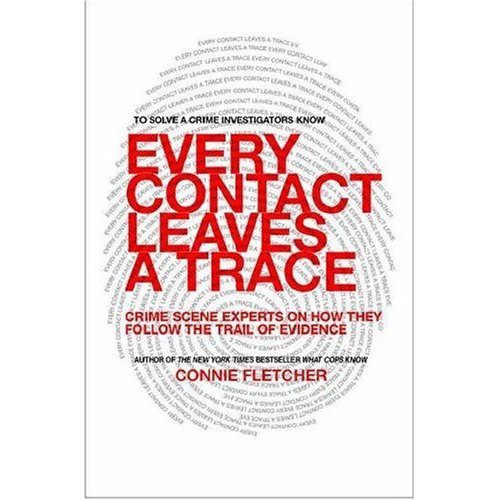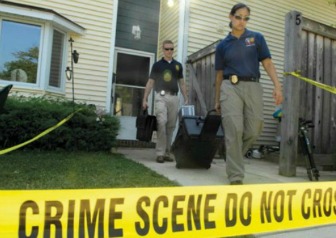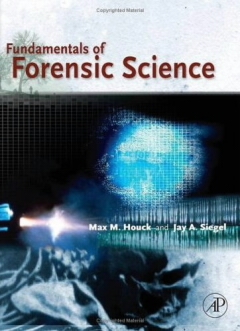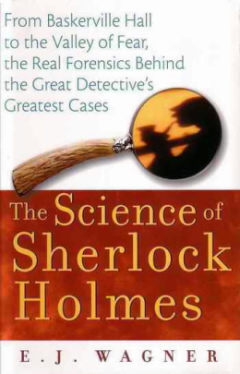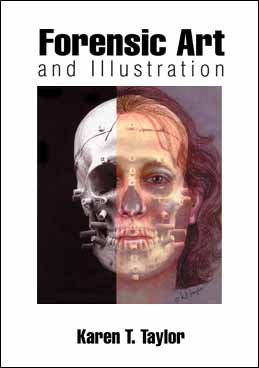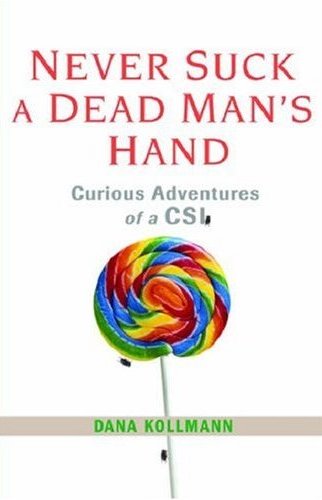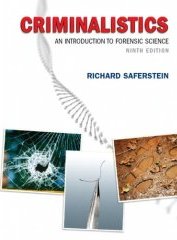|
Forensic Science Book Of The MonthWelcome to the forensic science book of the month page. Whether you are new to forensic science, currently studying or thinking about studying forensic science, or consider yourself an expert in the field, each of the forensic science books featured on this page will have something to offer you. They will also help further your understanding of the application of science within the criminal justice system and/or specific areas of forensic science theory and practice. August 2013Introduction to Forensic DNA Evidence for Criminal Justice Professionals By Jane Moira Taupin
Book Description The use of DNA profiling in forensic cases has been considered the most innovative technique in forensic science since fingerprinting, yet for those with limited scientific knowledge, understanding DNA enough to utilize it properly can be a daunting task. Introduction to Forensic DNA Evidence for Criminal Justice Professionals is designed for nonscientific readers who need to learn how to effectively use forensic DNA in criminal cases. Written by a forensic scientist world renowned for her expertise in clothing examination, the book provides a balanced perspective on the weight of DNA evidence. Going beyond a simple explanation of the methodology, it arms attorneys and other criminal justice professionals with knowledge of the strengths and limitations of the evidence, including the danger in relying on DNA statistical probabilities in the determination of guilt. The book covers the most common DNA methods used in criminal trials today—nuclear DNA short tandem repeat (STR) techniques, mitochondrial DNA, and Y-STR profiling. It helps prosecutors know when to emphasize DNA evidence or proceed with trial in the absence of such evidence. It assists defense lawyers in knowing when to challenge DNA evidence and perhaps employ an independent expert, when to focus elsewhere, or when to secure the advantage of an early guilty plea. By imparting practical and theoretical knowledge in an accessible manner, the book demystifies the topic to help both sides of the adversarial system understand where DNA evidence fits within the context of the case. See following link for more details: Introduction to Forensic DNA Evidence for Criminal Justice Professionals July 2013Clarke's Analytical Forensic Toxicology Edited By Adam Negrusz & Gail Cooper
Book Description This second edition of Clarke's Analytical Forensic Toxicology offers a fresh perspective on the drugs and poisons that you are most likely to encounter in forensic toxicology, with a focus on collection, extraction and analysis. With additional features incorporated from the fourth edition of Clarke's Analysis of Drugs and Poisons this text is fully updated to reflect the advances in analytical and forensic toxicology. New and extended chapters include: sampling, storage and stability; in-utero exposure to drugs of abuse; drug-facilitated sexual assault; and extraction. Providing unrivalled comprehensive coverage of analytical forensic toxicology, this book is a crucial resource for students of forensic science, toxicology, clinical pharmacology and analytical chemistry. It is an invaluable tool for teachers in these subject areas and a key resource for those working in forensic science laboratories. See following link for more details: Clarke's Analytical Forensic Toxicology June 2013Forensic Applications of Gas Chromatography (Analytical Concepts in Forensic Chemistry) By Michelle Groves Carlin & John Richard Dean
Book Description Several areas of forensic science use the technique of gas chromatography, ranging from fire analysis to the investigation of fraudulent food and perfumes. Covering the essentials of this powerful analytical technique, Forensic Applications of Gas Chromatography explains the theory and shows applications of this knowledge to various realms of forensic science. Topics include: Real examples supplement the text, along with questions in each chapter. The book includes examples of applications of gas chromatography in drugs, toxicology, fire, paint, food, and fragrance. Each application is presented as an individual case study with specific focus on a particular sample preparation technique. This allows each technique to be discussed with respect to its theory, instrumentation, solvent selection, and function, as appropriate. Each case study provides readers with suitable practical information to allow them to perform experiments in their own laboratory either as part of a practical laboratory class or in a research context. The final chapter provides answers to the questions and encourages further study and discussion. See following link for more details: Forensic Applications of Gas Chromatography (Analytical Concepts in Forensic Chemistry) May 2013Forensic Botany: A Practical Guide By David Hall & Jason Bird
Book Description Forensic Botany: A Practical Guide is an accessible introduction to the way in which botanical evidence is identified, collected and analysed in criminal cases. Increasingly this form of evidence is becoming more important in forensic investigation and yet there are few trained botanists able to assist in such cases. This book is intended to show how useful simple collection methods and standard plant analysis can be in the course of such investigations and is written in a clear and accessible manner to enhance understanding of the subject for the non-specialist. Clearly structured throughout, this book combines well known collection techniques in a field oriented format that can be used for casework. Collection of evidence differs from formal plant collection in that most professional plant collectors are gathering entire plants or significant portions of a plant for permanent storage and reference. Evidence frequently consists of fragments, sometimes exceedingly tiny. Exemplars (examples of reference plants) are collections of plants made in the manner a botanist would collect them. These collections are necessary to link or exclude evidence to or from a scene. Various methods that allow easy collection, transportation, and preservation of evidence are detailed throughout the book. This book is written for those who have no formal background working with plants. It can be used as a practical guide for students taking forensic science courses, law enforcement training, legal courses, and as a template for plant collection at any scene where plants occur and where rules or laws are involved. Veterinarians, various environmental agencies, anthropologists, and archeologists are examples of disciplines that are more recently in need of plant evidence. Veterinarians are becoming more active in pursuing cases of animals that have been abused or are victims of illegal killing. Anthropologists and archeologists are often called to help with body recovery in outdoor environments. Environmental agencies are increasingly forced to adopt rules for resource protection, are in need of a guide for procedures for plant evidence collection and application. The format of the book is designed to present the reader with all the information needed to conduct a botanical analysis of a crime scene; to highlight the forensic significance of the botanical evidence that may be present; how to collect that evidence in the correct manner and preserve and store that evidence appropriately- also shows how to conduct a laboratory analysis of the plants. See following link for more details: Forensic Botany: A Practical Guide April 2013Forensic Science For Writers By Phil Jones
Book Description Do you want forensics to play a starring role in your fiction, but you find that you're not quite sure what it's all about? Forensic Science for Writers reveals how investigators analyze blood, DNA, fingerprints, hair, documents, ammunition, corpses, and other physical evidence. From the code-breaking tricks of the cyber-sleuth to the traditional procedures of the autopsy room, you'll investigate the strengths and weaknesses of forensic science. Forensic Science for Writers is not just about science. And it's not just about forensic speak. You'll learn how to use forensics to create plot twists. And you'll see how best-selling authors successfully incorporated forensic science in their stories. You'll also learn common misconceptions about forensic analysis that plague films and novels - the types of errors that you'll want to avoid in your own writing. This book is based upon an online course that was offered through colleges and other organizations. More than 800 students took the course, including writers, schoolteachers, law enforcement personnel, and attorneys. See following link for more details: March 2013Forensic Toxicology: Medico-Legal Case Studies By Kalipatnapu N. Rao
Book Description Modern technology using state-of-the-art equipment can now identify almost any toxin relevant to a legal issue. Techniques include gas chromatography, mass spectrometry, high-pressure liquid chromatography, and the combination of these methods. Forensic Toxicology: Medico-legal Case Studies demonstrates how the science of forensic toxicology acts as a bridge between medicine and law. Tracking the progression of toxicology findings from the laboratory to the courtroom, it prepares practicing toxicologists to write reports and testify at depositions and in court. The book explains the organization of clinical laboratories and includes sections on accreditation, quality control, method validation, and other critical topics. It provides an overview of the U.S. legal system, describes the process of writing a toxicology report, and offers techniques for deposition and courtroom testimony. Covering a broad range of topics, the book offers detailed analysis of situations ranging from the rare and unusual to those that toxicologists most often confront, including: Written in an accessible and well-organized style, this volume is an essential guide for forensic toxicologists at all levels who need to understand how to best present the science of toxicology in the forensic arena. See following link for more details: Forensic Toxicology: Medico-Legal Case Studies February 2013Criminalistics Laboratory Manual: The Basics of Forensic Investigation By Elizabeth Erickson
Book Description Criminalistics Laboratory Manual provides students who have little to no prior knowledge of forensic science with a practical crime scene processing experience. The manual starts with an original crime scene narrative, setting up the crime students are to solve. This narrative is picked up in each of the 17 forensic science lab activities, tying all forensic disciplines together to show the integrated workings of a real crime lab. The lab activities cover fingerprints, blood typing and spatter analysis, hair and fiber, digital forensics and more. After completing all of the exercises, the student will be able to solve the homicide based on forensic evidence. Each chapter also includes an introduction to the type of forensic evidence covered, and practice exercises and key definitions prepare students for the laboratory exercise. While fitting in with the larger crime scene narrative, the individual chapters are written so that they can be used separately, giving instructors flexibility. Key Features See following link for more details: Criminalistics Laboratory Manual: The Basics of Forensic Investigation January 2013Criminal Investigation: An Illustrated Case Study Approach By James R. Lasley & Nikos R Guskos
Book Description Criminal Investigation: An Illustrated Case Study Approach is today’s most modern, complete, visual, and “reality-based” guide to criminal investigation. Unlike other texts, it presents both written cases and a full sequence of photos for each case, enabling students to view crime scenes from top-to-bottom, and realistically apply investigative concepts. The authors first introduce core investigative tools, demonstrating the proper use of law and evidence gathering techniques. Next, they present detailed methods for investigating a wide spectrum of specific crimes. Each type of crime is illuminated with a detailed case study and a complete series of properly-sequenced crime scene photos. This text’s “no punches pulled” coverage helps students understand exactly what to expect in the field. It also contains detailed coverage of many crimes that other books overlook, including street gang crime, and crimes involving explosives. See following link for more details: Criminal Investigation: An Illustrated Case Study Approach December 2012Forensic Ecology Handbook: From Crime Scene to Court Edited By Nicholas Márquez-Grant & Julie Roberts
Book Description The analysis of plants, insects, soil and other particulates from scenes of crime can be vital in proving or excluding contact between a suspect and a scene, targeting search areas, and establishing a time and place of death. Forensic Ecology: A Practitioner’s Guide provides a complete handbook covering all aspects of forensic ecology. Bringing together the forensic applications of anthropology, archaeology, entomology, palynology and sedimentology in one volume, this book provides an essential resource for practitioners in the field of forensic science, whether crime scene investigators, forensic science students or academics involved in the recovery and analysis of evidence from crime scenes. Forensic Ecology Handbook: From Crime Scene to Court includes information not only on the search, location, recovery and analysis of evidence, but includes sampling strategies for diatom analysis, pollen and soils samples and entomology and provides guides for good practice. Each chapter provides background information on each discipline and is structured according to pre-scene attendance (what questions should the scientist ask when receiving a call? What sort of preparation is required?), scene attendance (including protocols at the scene, sampling strategies, recording), scientific examination of analysis of the evidence up to the stages and guidelines for witness statement and presenting evidence in court. The book is written by specialists in all fields with a wealth of experience who are current forensic practitioners around the world. It provides an essential and accessible resource for students, academics, forensic practitioners and police officers everywhere. See following link for more details: Forensic Ecology: From Crime Scene to Court November 2012Digital Forensics Explained By Greg Gogolin, Ph.D.
Book Description The field of computer forensics has experienced significant growth recently and those looking to get into the industry have significant opportunity for upward mobility. Focusing on the concepts investigators need to know to conduct a thorough investigation, Digital Forensics Explained provides an overall description of the forensic practice from a practitioner’s perspective. Starting with an overview, the text describes best practices based on the author’s decades of experience conducting investigations and working in information technology. It illustrates the forensic process, explains what it takes to be an investigator, and highlights emerging trends. Filled with helpful templates and contributions from seasoned experts in their respective fields, the book includes coverage of: The text includes acquisition forms, a sequential process outline to guide your investigation, and a checklist of supplies you’ll need when responding to an incident. Providing you with the understanding and the tools to deal with suspects who find ways to make their digital activities hard to trace, the book also considers cultural implications, ethics, and the psychological effects that digital forensics investigations can have on investigators. See following link for more details: October 2012Scientific Protocols for Fire Investigation By John J. Lentini
Book Description Knowledge of the science behind fires is critical to understanding a fire’s cause and successfully presenting that determination to the authorities or in litigation. Now in its second edition, Scientific Protocols for Fire Investigation focuses on the practical application of scientific principles to determine the causes of fires. Uniquely qualified with years of experience in on-site investigations, lab analyses, and courtroom presentation, the author provides a resource that is unparalleled in depth and focus. The book explores: The final chapter discusses the professional practice of fire investigation. It examines quality assurance, business practices, and the fundamentals of being an expert witness, with advice for giving testimony in depositions and at trial. Other highlights of the second edition include new and expanded discussions on novel training methods, first assumptions, computer fire modeling, low voltage ignition sources, the questionable validity of some origin determinations, and recent changes in NFPA 921. Thorough and accessible, this volume not only provides the practical information necessary to conduct an effective inquiry but also offers insight into the science, history, and theory behind what makes fire investigation a multi-faceted profession. See following link for more details: Scientific Protocols for Fire Investigation, Second Edition (Protocols in Forensic Science) September 2012Introduction To Forensic Geoscience By Elisa Bergslien
Book Description An Introduction to Forensic Geoscience provides fundamental training in geoscience as developed through the lens of its forensic applications. It incorporates a range of topics including geophysical methods of grave detection, the mineralogy of art, identification of microfossils, and comparison of soil trace evidence samples. Each topic is introduced using core concepts that are developed with increasing complexity in order to give readers an understanding of the underlying scientific principles involved and a taste of the wide range of possible forensic uses. A variety of detailed reference tables have been compiled for the text and each chapter contains lists of references to applicable textbooks and journal articles. Examples of real criminal cases are also presented in each chapter to make the connections between theory and real world application. The goal of this book is to give readers a familiarity with the wide range of ways in which geoscience principles and geological materials can be utilized forensically. See following link for more details: An Introduction to Forensic Geoscience August 2012The Science of Crime Scenes By Max M. Houck, Frank Crispino & Terry McAdam
Book Description The recent National Research Council's report on forensic science calls for more fundamental education and training in the science behind the discipline. Nowhere is this need greater than in crime scene investigations. Long seen as merely "bagging and tagging," crime scene investigation and processing is now a complex process, involving numerous sciences and methods. The Science of Crime Scenes addresses the science behind the scenes and demonstrates the latest methods and technologies in depth. The Science of Crime Scenes covers the philosophy of crime scenes as historical events, the personnel involved at a scene (including the media), the detection of criminal traces and their reconstruction, and special crime scenes, such as mass disasters and terroristic events. Written by an international trio of authors with decades of crime scene experience, The Science of Crime Scenes is the next generation of crime scene textbooks. See following link for more details: July 2012A Companion to Forensic Anthropology Edited By Dennis Dirkmaat
Book Description A Companion to Forensic Anthropology presents the most comprehensive assessment of the philosophy, goals, and practice of forensic anthropology currently available, with chapters by renowned international scholars and experts. See following link for more details: A Companion to Forensic Anthropology June 2012Mass Spectrometry Handbook Edited By Michael S. Lee
Book Description Due to its enormous sensitivity and ease of use, mass spectrometry has grown into the analytical tool of choice in most industries and areas of research. This unique reference provides an extensive library of methods used in mass spectrometry, covering applications of mass spectrometry in fields as diverse as drug discovery, environmental science, forensic science, clinical analysis, polymers, oil composition, doping, cellular research, semiconductor, ceramics, metals and alloys, and homeland security. The book provides the reader with a protocol for the technique described (including sampling methods) and explains why to use a particular method and not others. See following link for more details: May 2012Techniques of Crime Scene Investigation, By Barry Fisher & David Fisher
Book Description The application of science and technology plays a critical role in the investigation and adjudication of crimes in our criminal justice system. But before science can be brought to bear on evidence, it must be recognized and collected in an appropriate manner at crime scenes. Written by authors with over 50 years of combined experience in forensic science, Techniques of Crime Scene Investigation examines the concepts, field-tested techniques, and procedures of crime scene investigation. Detectives, crime scene technicians, and forensic scientists can rely on this updated version of the "forensics bible" to effectively apply science and technology to the tasks of solving crimes. What’s New in the Eighth Edition: See following link for more details: Techniques of Crime Scene Investigation, Eighth Edition (Forensic and Police Science) April 2012Ethics in Forensic Science Edited By J.C Upshaw Downs & Anjali R. Swienton
Book Description Ethics in forensic science draws upon the expertise of the editors as authors and various contributors in order to present several different perspectives with the goal of approaching and understanding when ethical lines are crossed. In order to achieve this goal, comparisons of various canons of ethics from related fields such as medicine, law, the military, science and politics are examined and applied. Case studies are presented throughout to illustrate ethical dilemmas and challenge the reader with the goal of greater understanding. Key Features: See following link for more details: March 2012A Dictionary of Forensic Science By Suzanne Bell
Book Description Written by renowned forensic science researcher Dr Suzanne Bell, this is the most up-to-date A to Z of forensic science available. Containing over 1,300 entries covering terms and concepts in Forensic Science, including specialist terms in the areas of chemistry, biology, anthropology, art, engineering, firearms, toolmarks, trace evidence, crime scene investigation, case history, biographies of investigators and criminals, as well as forensic computing. Many entries are accompanied by case examples, figures, photographs and web links, making this A to Z an invaluable reference for students of forensic science, as well as professionals and those with an interest in forensics. See following link for more details: A Dictionary of Forensic Science February 2012Comparative Osteology: A Laboratory and Field Guide of Common North American Animals By Bradley Adams & Pam Crabtree
Book Description In the forensic context it is quite common for nonhuman bones to be confused with human remains and end up in the medical examiner or coroner system. It is also quite common for skeletal remains (both human and nonhuman) to be discovered in archaeological contexts. While the difference between human and nonhuman bones is often very striking, it can also be quite subtle. Fragmentation only compounds the problem. The ability to differentiate between human and nonhuman bones is dependent on the training of the analyst and the available reference and/or comparative material. Comparative Osteology is a photographic atlas of common North American animal bones designed for use as a laboratory and field guide by the forensic scientist or archaeologist. The intent of the guide is not to be inclusive of all animals, but rather to present some of the most common species which also have the highest likelihood of being potentially confused with human remains. See following link for more details: Comparative Osteology: A Laboratory and Field Guide of Common North American Animals January 2012Introduction to Criminal Investigation Edited By Michael Birzer & Cliff Roberson
Book Description The manner in which criminal investigators are trained is neither uniform nor consistent, ranging from sophisticated training protocols in some departments to on-the-job experience alongside senior investigators in others. Ideal for students taking a first course in the subject as well as professionals in need of a refresher, Introduction to Criminal Investigation uses an accessible format to convey concepts in practical, concrete terms. Topics discussed include: Bringing together contributions from law enforcement personnel, academics, and attorneys, the book combines practical and theoretical elements to provide a comprehensive examination of today’s criminal investigative process. The accessible manner in which the information is conveyed makes this an ideal text for a wide-ranging audience. See following link for more details: Introduction to Criminal Investigation December 2011Forensic Recovery of Human Remains: Archaeological Approaches By Tosha L. Dupras, John J. Schultz, Sandra M. Wheeler and Lana J Williams
Book Description This book, now in its second edition, is a comprehensive guide that focuses on the practical aspects of excavating and recovering human remains, as well as any associated evidence, from crime scenes. It highlights the protocols and techniques that are used to successfully survey, map, recover, document, collect, and transport evidence. New additions include discussion questions and suggested readings, updated mapping and measuring techniques, including a section on GIS and backpack differential GPS systems, expanded information on botany, DNA, and soil, and non-forensic burial contexts. Almost 200 illustrations are included to help clarify concepts. See following link for more details: Forensic Recovery of Human Remains: Archaeological Approaches November 2011Forensic Neuropsychology: A Scientific Approach Edited By Glenn J. Larrabee
Book Description Neuropsychologists are frequently asked to serve as experts for court cases where judgments must be made as to the cause of, and prognosis for, brain diseases and injuries, as well as the impact of brain dysfunction on legal competencies and responsibilities. This fully-updated second edition describes the application of neuropsychology to legal issues in both the civil and criminal courts. The book emphasizes the scientific basis of neuropsychology, as well as using a scientific approach in addressing forensic questions. All of the contributors are recognized experts in their fields, and the chapters cover common forensic issues such as appropriate scientific reasoning, the assessment of malingering, productive attorney-neuropsychologist interactions, admissibility of neuropsychological evidence, and ethics. Also covered are functional neuroimaging in forensic neuropsychology and the determination of damages in personal injury litigation, including pediatric brain injury (traumatic injury and perinatal birth injury), mild, moderate, and severe traumatic brain injury in adults, neurotoxic injury, chronic pain, post-traumatic stress disorder, and assessment of medically unexplained symptoms. Civil competencies in elderly persons with dementia are addressed in a separate chapter, and two chapters deal with the assessment of competency and responsibility in criminal forensic neuropsychology. The book closes with a perspective on trends in forensic practice and research. See following link for more details: Forensic Neuropsychology: A Scientific Approach October 2011From Crime Scene to Courtroom: Examining the Mysteries Behind Famous Cases By Cyril H. Wecht & Dawna Kaufmann
Book Description If you think the media has told you everything there is to know about Michael Jackson and Casey Anthony, think again! In this engrossing, almost cinematic page-turner, famed forensic pathologist Dr. Cyril H. Wecht and veteran true-crime journalist Dawna Kaufmann offer never-before-published information on the mysterious deaths of Michael Jackson and Caylee Anthony, plus five other ripped-from-the-headlines criminal cases. Based on their long investigative experience, these two insiders offer revealing insights into the following high-profile cases: Casey Anthony An assessment of the Trial of this Century, during which a Florida mother stood accused of killing her young daughter, Caylee. At stake were issues that included accuracy of air sampling and cadaver dogs, post-mortem hair banding, chloroform, duct tape identification, computer clues, and deep family secrets. Michael Jackson The authors provide never-disclosed data on the autopsies of Jackson's body and a microscopic view of the singer's life and career, plus analysis of the cardiologist charged with his death: Was Dr. Conrad Murphy recklessly negligent or a fall guy for a hopelessly addicted celebrity? Drew Peterson Heroic Illinois SWAT team cop or wife killer? Did his third wife slip and fall in the bathtub, or was she beaten and drowned? The controversy over her death led to an exhumation and the filing of homicide charges against him, but can prosecutors prove their case? And what happened to his fourth wife, who remains missing? Rolling Stone Brian Jones Was the rock musician's death an accident or something more sinister? And was he impaired by drugs or alcohol when he died? After more than forty years, there is finally an answer. See following link for more details: From Crime Scene to Courtroom: Examining the Mysteries Behind Famous Cases September 2011Forensic Chemistry Handbook Edited By Lawrence Kobilinsky
Book Description The Forensic Chemistry Handbook focuses on topics in each of the major chemistry-related areas of forensic science. With chapter authors that span the forensic chemistry field, this book exposes readers to the state of the art on subjects such as serology (including blood, semen, and saliva), DNA/molecular biology, explosives and ballistics, toxicology, pharmacology, instrumental analysis, arson investigation, and various other types of chemical residue analysis. In addition, the Forensic Chemistry Handbook: Media focus on high-profile trials like those of Scott Peterson or Kobe Bryant have peaked a growing interest in the fascinating subject of forensic chemistry. For those readers who want to understand the mechanisms of reactions used in laboratories to piece together crime scenes—and to fully grasp the chemistry behind it—this book is a must-have. See following link for more details: August 2011An Introduction to Forensic Genetics By William Goodwin, Adrian Linacre & Sibte Hadi
Book Description This is a completely revised edition of a comprehensive and popular introduction to the fast moving area of Forensic Genetics. The text begins with key concepts needed to fully appreciate the subject and moves on to examine the latest developments in the field. Now illustrated in full colour throughout, this accessible textbook includes numerous references to relevant casework. With information on the full process of DNA evidence from collection at the scene of a crime to presentation in a legal context this book provides a complete overview of the field. Key Features: Included in the Forensic Science Society 'Essentials in Forensic Science' book series. This edition is to be included in the Forensic Science Society 'Essentials of Forensic Science' book series aimed at advanced level undergraduates and new practitioners to the field. See following link for more details: An Introduction to Forensic Genetics (Essential Forensic Science) July 2011Cold Cases: An Evaluation Model with Follow-up Strategies for Investigators by James M. Adcock & Sarah L. Stein
Book Description Cold Cases: An Evaluation Model with Follow-up Strategies for Investigators provides a comprehensive roadmap for digging those cold cases out of the file room and getting them resolved. Practical and concise, the book is an invaluable tool for police officers and detectives attempting to solve crimes that would otherwise be forgotten. Evaluating the Case Divided into three sections, the book begins with a historical perspective on how cases get to the point where it appears all investigative leads have been exhausted. It includes a chapter on understanding the process of homicide and those who kill — critical information for the homicide investigator. Next, the authors explain the evaluation model. They demonstrate the key elements of organization, thoroughness, and the value of the scientific method. This section validates theories of the crime, raises evidentiary issues and concerns, addresses the informational and behavioral aspects relative to the crime and the participants in the crime, and documents investigative strategies for future efforts on the case. Investigating and Solving the Crime The third section discusses the investigation that follows the evaluation. The book considers questions investigators must ask, including what should be looked at beyond the case file itself, and how the growth in technology since the date of the incident might provide new opportunities to uncover clues. This section also explores the choice of interview/interrogation techniques based on the behavioral aspects involved. Finally, the authors suggest how investigators can maximize their efforts and obtain not just an arrest, but a conviction. Useful appendices include sample standard operating procedures from three different agencies to use as a guide for setting up a cold case unit and a list of additional resources a department may look to for assistance. By following the cold cases evaluation model in this volume, those charged with resolving long-forgotten crimes can increase their chance of an accurate resolution, or at least be able to say that everything that can be done has been done. See following link for more details: Cold Cases: An Evaluation Model with Follow-up Strategies for Investigators June 2011Forensic Anthropology Laboratory Manual by Steven N. Byers
Book Description This unique, step-by-step workbook introduces students to all the procedures of the forensic anthropology protocol while providing even, balanced coverage of the core topics. Tear-out exercise worksheets reinforce the methodologies of forensic anthropology and enhance student comprehension. Each chapter contains detailed explanations of the terminology, osteological features, and measurements needed to understand each of the topics covered. Chapters may be covered in one session or multiple sessions and lists both basic and optional lab materials in chapter openers, enabling instructors to tailor each lab to the resources they have available. See following link for more details: Forensic Anthropology Laboratory Manual (3rd Edition) May 2011Oxford Handbook of Forensic Medicine by Jonathan Wyatt, Tim Squires, Guy Norfolk & Jason Payne-James
Book Description Forensic medicine covers an amazing range of different subjects and no single individual can expect to be an expert in all of them. The Oxford Handbook of Forensic Medicine provides comprehensive coverage of all areas within this complex discipline. Written for specialists and non-specialists alike, it will appeal to practising forensic scientists, as well as lawyers, police officers, and forensic science students. It shows how forensic medicine has been used in specific cases enabling the reader to apply their knowledge in real life. A detailed glossary of medical terms helps those without medical training to understand medical reports and practices. This easily-portable guide is essential reading for the busy clinical forensic doctor or nurse, and others working at the interface between medicine and law. See following link for more details: Oxford Handbook of Forensic Medicine April 2011Current Practice in Forensic Medicine: Edited by John Gall & Jason Payne-James
Book Description This text aims to provide a unique, in-depth and critical update on selected topics that are of direct relevance to those practicing in the field including lawyers, police, medical and dental practitioners, forensic scientists and postgraduate/undergraduate medical students and undergraduate law students preparing for forensic medicine examinations. The books covers the wider aspects of forensic medicine, including the law, science, medicine (forensic pathology, clinical forensic medicine and forensic psychiatry) and dentistry. Topics covered include subjects of debate and/or uncertainty in areas where significant advances have been made and in those of current relevance to the forensic profession, Chapters provide a variety of approaches to the areas under discussion with reviews of current knowledge, information on significant changes and pointers to the future that the reader should be aware of. Key Features: See following link for more details: Current Practice in Forensic Medicine March 2011Microbial Forensics: Edited by Bruce Budowle et al
Book Description Microbial Forensics is a rapidly evolving scientific discipline. In the last decade, and particularly due to the anthrax letter attacks in the United States, microbial forensics has become more formalized and has played an increasingly greater role in crime investigations. This has brought renewed interest, development and application of new technologies, and new rules of forensic and policy engagement. Microbial Forensics has many applications ranging from biodefense, criminal investigations, providing intelligence information, making society more secure, and helping protect precious resources, particularly human life. A combination of diverse areas is investigated, including the major disciplines of biology, microbiology, medicine, chemistry, physics, statistics, population genetics, and computer science. See following link for more details: February 2011Crime Scene Investigation and Reconstruction by Robert Ogle
Book Description Taking a systematic approach, Crime Scene Investigation and Reconstruction outlines techniques that will help investigators answer the critical what, who, when questions of crime scene investigations. With a focus on crime scene processing, the book includes the latest on database technologies, digital cameras, DNA analyses and computer-aided crime scene reconstructions. Each chapter includes introductions and summaries that demystify the technical aspects of the field. This edition includes a separate chapter on crime scene reconstruction, the latest on search and seizure laws and updated photographs that show efficient and effective crime scene investigation methods. This textbook is a necessary supplement to courses in criminal investigation, criminalistics, and a wide range of other forensic science courses. Law enforcement agencies will also find this book to be a valuable reference manual. See following link for more details: Crime Scene Investigation and Reconstruction (3rd Edition) January 2011The Forensic Laboratory Handbook: Procedures and Practice by Ashraf Mozayani & Carla Noziglia
Book Description A comprehensive and easy-to-read introduction to the work of the modern forensic laboratory. The authors explain in simple language the capabilities and limitations of modern forensic laboratory procedures, techniques, analyses, and interpretations. Here, the interested reader will find an understandable and fascinating introduction to the complex worlds of forensic serology DNA, chemistry, crime reconstruction, digital evidence, explosives, arson, fingerprints, firearms, tool marks, odontology, and pathology. Additional chapters address the problems of assuring quality and seeking trace evidence in the forensic laboratory. See following link for more details: The Forensic Laboratory Handbook: Procedures and Practice December 2010Forensic Science in Court: Challenges in the Twenty First Century by Donald Shelton
Book Description Forensic Science in Court explores the legal implications of forensic science - an increasingly important and complex part of the justice system. Judge Donald Shelton provides an accessible overview of the legal issues, from the history of evidence in court, to 'gatekeeper' judges determining what evidence can be allowed, to the 'CSI effect' in juries. The book describes and evaluates various kinds of evidence, including DNA, fingerprints, handwriting, hair, bite marks, tool marks, firearms and bullets, fire and arson investigation, and bloodstain evidence. Assessing the strengths and limitations of each kind of evidence, the author also discusses how they can contribute to identifying the 'who,' 'how,' and 'whether' questions that arise in criminal prosecutions. Author Donald Shelton draws on the depth of his experiences as courtroom prosecutor, professor, and judge, to provide a well-rounded look at these increasingly critical issues. Case studies throughout help bring the issues to life and show how forensic science has been used, both successfully and not, in real-world situations. See following link for more details: Forensic Science in Court: Challenges in the Twenty First Century November 2010Forensic Science: A Very Short Introduction by Jim Fraser
Book Description Due to its connections to violent crime and ingenious detective work, forensic science is a subject of endless fascination to the general public. A criminal case can often hinge on a piece of evidence such as a hair, a blood trace, a bit of saliva on a cigarette butt, or the telltale mark of a tire tread. High profile cases have stoked this interest in recent years and some of the most popular shows on television - such as CSI: Crime Scene Investigation and its raft of spin-offs - attest to the enduring popularity of forensic science as a form of grisly entertainment. This Very Short Introduction looks at the nature of forensic science, examining what forensic science is, how it is used in the investigation of crime, how crime scenes are managed, how forensic scientists work, the different techniques used to recover evidence, and the range of methods available for analysis. The book also considers how forensic science serves the criminal justice system and the challenges of communicating complex scientific evidence in a court of law. See following link for more details: Forensic Science: A Very Short Introduction October 2010The Use of Forensic Anthropology By Robert B. Pickering & David Bachman
Book Description A forensic investigation requires a team of specialists from many different scientific fields of study along with legal and law enforcement specialists. In recent years, the range of cases on which forensic anthropologists have been consulted has expanded dramatically. The Use of Forensic Anthropology provides these professionals with guidelines for determining how to choose and when to use a forensic anthropologist. The book begins with a historical overview of the field of forensic anthropology, and then presents basic information about how to approach a forensic recovery site. When skeletal or severely decomposed remains are discovered, normal methods of identification such as facial recognition and fingerprinting are ineffective. This book offers insights on how to find the right professional to assist with these difficult cases. One of the key features is a chapter which presents a series of ten questions that must be answered, in order, about each case. Using this checklist will ensure the team working on the case that no stone is left unturned. Later chapters examine the relevance of race, ethnicity, and ancestry, determination of time of death, new investigation techniques, DNA, and categories of trauma. The final chapter brings the various parts of the process together to reconstruct a case. The first responder to a scene with skeletal remains and the law enforcement agencies who become involved will likely be confronted with evidence that they cannot interpret. This volume provides a bridge for these professionals, enabling them to develop a standard protocol for investigating skeletal remains, highlighting important questions that must be answered, and assisting them in finding the right forensic anthropologist to solve the puzzle of an unexplained death. See following link for more details: The Use of Forensic Anthropology September 2010Stable Isotope Forensics: An Introduction to the Forensic Application of Stable Isotope Analysis by Wolfram Meier-Augenstein
Book Description This book provides the first comprehensive, overview and guide to forensic isotope analysis, an exciting new application of stable isotope analytical techniques. Topics are introduced using examples and real-life case studies such as food quality control where isotope analysis has already had a major impact, in terms of consumer protection, These examples illustrate the underlying principles of isotope profiling or fingerprinting. A section comprising actual criminal case work is used to build a bridge between the introduction and the technical section to encourage students to engage with this novel departure for analytical sciences while at the same time providing hands-on examples for the experienced researcher and forensic practitioner to match problems and success stories encountered with the topics discussed in the technical section. What little information is available on the subject in book form so far, has been published as individual chapters in books dealing either with mass spectrometry, forensic geoscience or environmental forensics, this is the first book to focus on the entire spectrum of forensic isotope analysis and will be an invaluable reference to both researchers in the field and forensic practitioners. See following link for more details: August 2010Essential Mathematics and Statistics for Forensic Science by Craig Adam
Book Description This text is an accessible, student-friendly introduction to the wide range of mathematical and statistical tools needed by the forensic scientist in the analysis, interpretation and presentation of experimental measurements. From a basis of high school mathematics, the book develops essential quantitative analysis techniques within the context of a broad range of forensic applications. This clearly structured text focuses on developing core mathematical skills together with an understanding of the calculations associated with the analysis of experimental work, including an emphasis on the use of graphs and the evaluation of uncertainties. Through a broad study of probability and statistics, the reader is led ultimately to the use of Bayesian approaches to the evaluation of evidence within the court. In every section, forensic applications such as ballistics trajectories, post-mortem cooling, aspects of forensic pharmacokinetics, the matching of glass evidence, the formation of bloodstains and the interpretation of DNA profiles are discussed and examples of calculations are worked through. In every chapter there are numerous self-assessment problems to aid student learning. Its broad scope and forensically focused coverage make this book an essential text for students embarking on any degree course in forensic science or forensic analysis, as well as an invaluable reference for post-graduate students and forensic professionals. Key features: See following link for more details: Essential Mathematics and Statistics for Forensic Science July 2010Cold Case Homicides: Practical Investigative Techniques by Richard H. Walton
Book Description Written by a seasoned professional with over 30 years of experience in law enforcement, Cold Case Homicides: Practical Investigative Techniques provides effective and accessible information to those responsible for investigating and resolving previously examined - but still unsolved - cold case homicides. The book merges theory with practice through the use of case histories, photographs, illustrations, and checklists that convey essential, fundamental concepts while providing a strong, practical basis for the investigative process. It combines proven techniques from forensics, psychology, and criminal investigation, and focuses on technologies that may not have been available at the time of the crime. This guide defines the characteristics of a cold case homicide; details various investigative methods used by law enforcement agencies; explores the actual experiences of detectives in re-opening case files; and presents current technologies such as ViCAP, HITS, and TracKRS used in the identification of cases related to the re-opened case, or its perpetrator. It also highlights technological changes that contribute greatly to law enforcement's abilities to solve cold case homicides such as computerized print technology, the specificity of DNA, and the expanding data banks that enable the linkage of previously unknown suspects to the crimes they committed. Addressing methods particularly valuable to cold cases, Cold Case Homicides: Practical Investigative Techniques assists the investigator in being prepared, focused, objective - and successful in obtaining the truth. See following link for more details: Cold Case Homicides: Practical Investigative Techniques June 2010Fifty Years of Forensic Science by Niamh Nic Daeid
Book Description Over the last half century, the science and practice of forensic science has undergone dramatic changes. Since the early 1960s the technological developments and their application to forensic science have been immense. Not only that, the application of science within a legal context and framework has developed enormously, as has the evaluation of the analytical results obtained. This unique text looks at the changes and challenges within forensic science over the last fifty years through a continuous diary of development witnessed by the editorials and relevant correspondence delivered through the UK Forensic Science Societies’ journal Science and Justice (formally the Journal of the Forensic Science Society). The editorials are divided into sections relating to the developments of forensic practice, the advancement of science, education, legal aspects, forensic science and medicine, the international dimension of forensic science and the interpretation and evaluation of evidence. See following link for more details: Fifty Years of Forensic Science May 2010Genetic Witness: Science, Law, and Controversy in the Making of DNA Profiling by Jay D. Aronson
Book Description When DNA profiling was first introduced into the American legal system in 1987, it was heralded as a technology that would revolutionize law enforcement. As an investigative tool, it has lived up to much of this hype - it is regularly used to track down unknown criminals, put murderers and rapists behind bars, and exonerate the innocent. Yet, this promise took ten turbulent years to be fulfilled. In Genetic Witness, Jay D. Aronson uncovers the dramatic early history of DNA profiling that has been obscured by the technique's recent success. He demonstrates that robust quality control and quality assurance measures were initially nonexistent, interpretation of test results was based more on assumption than empirical evidence, and the technique was susceptible to error at every stage. Most of these issues came to light only through defense challenges to what prosecutors claimed to be an infallible technology. Although this process was fraught with controversy, inefficiency, and personal antagonism, the quality of DNA evidence improved dramatically as a result. Aronson argues, however, that the dream of a perfect identification technology remains unrealized. See following link for more details: Genetic Witness: Science, Law, and Controversy in the Making of DNA Profiling April 2010Criminal Investigation by Kären M. Hess & Christine Hess Orthmann
Book Description Criminal Investigation, 9th Edition stresses practical procedures, techniques, and applications of private and public investigations to provide students with a solid foundation in criminal investigation. Criminal Investigation features updated, enhanced coverage of such important topics as terrorism and homeland security, cybercrime, forensics and physical evidence, federal law enforcement investigations, report writing, crimes against children, photography and sketching, preparing and presenting cases in court, and identity theft. Criminal Investigation, 9th Edition also includes a carefully structured learning system, checklists, and visuals to make learning easy. See following link for more details: March 2010Criminalistics: An Introduction to Forensic Science (10th Edition) by Richard Saferstein
Book Description Criminalistics is the definitive source for forensic science because it makes the technology of the modern crime laboratory clear to the non-scientist. Written by a well-known authority, the text covers the comprehensive realm of forensics and its role in criminal investigations. Physical evidence collection and preservation techniques are examined in detail—including chapters on Computer Forensics and DNA. By referencing real cases throughout, Criminalistics, 10th edition captures the pulse and intensity of forensic science investigations and the attention of the busiest student. Some new, exciting features for this edition include: Criminalistics: An Introduction to Forensic Science (10th Edition) Aims at making the subject of forensic science comprehensible to a wide variety of readers who are planning on being aligned with the forensic science profession. See following link for more details: Criminalistics: An Introduction to Forensic Science (10th Edition) February 2010Forensic Science in Court: The Role of the Expert Witness by Wilson Wall
Book Description Forensic Science in Court: The Role of the Expert Witness is a practical handbook aimed at forensic science students, to help them prepare as an expert witness when presenting their evidence in court. Written in a clear, accessible manner, the book guides the student through the legal process and shows them how to handle evidence, write reports without ambiguity through to the more practical aspects of what to do when appearing in court. The book also offers advice on what to expect when working with lawyers in a courtroom situation. An essential text for all students taking forensic science courses who are required to take modules on how to present their evidence in court. The book is also an invaluable reference for any scientist requested to give an opinion in a legal context. See following link for more details: Forensic Science in Court: The Role of the Expert Witness January 2010Crime Scene Investigation: The Forensic Technician's Field Manual by Tina Young & P.J. J Ortmeier
Book Description Written for courses in forensic technology and crime scene investigation, this field manual addresses the tasks performed by the person who identifies, photographs, documents, collects, preserves, and transports evidence at and from a crime scene. Covering a range of techniques and processes, it follows the guidelines established by the American Society of Crime Laboratory Directors and the International Association for Identification. The latest technological advancements are emphasized throughout and chapters includes numerous photographs, diagrams, learning objectives, case studies, lab exercises and more! See following link for more details: Crime Scene Investigation: The Forensic Technician's Field Manual December 2009Trace Evidence: Essentials of Forensic Science by Max. Houck
Book Description Evidence that can barely be seen with the naked eye routinely plays a crucial part in the search for and the conviction of some of the most dangerous criminals known to society. From the hairs of a dog to tiny fiber fragments, forensic analysts study these trace materials and interpret them for use in legal proceedings. Hairs and fibers are two of the most commonly found types of trace evidence and the focus of this book. "Trace Evidence" explores the microscopic world in which the forensic scientist works by addressing the issues of what constitutes evidence; important methods of trace analysis, including spectroscopy and chromatography; human and animal hairs and what can be determined by examining them; and manufactured and natural fibers and the many ways in which they appear in textiles and are analyzed in the laboratory. Written by a well-respected author with extensive knowledge in the field, this book is essential for students fascinated by this area of forensic science. The chapters include: 'What Is Evidence?' Forensic Applications, Hairs, and Fibers. See following link for more details: Trace Evidence (Essentials of Forensic Science) November 2009Hidden Evidence: 50 True Crimes and How Forensic Science Helped Solve Them by David Owen
Book Description This revised and updated history of forensics is expanded to include eight recent high-profile cases. David Owen takes readers to the scenes of 50 infamous crimes and provides detailed accounts of the scientific procedures used to catch criminals. The high-profile cases range from as early as 1775, when Paul Revere used dentures to identify a slain soldier, to as recent as the tragic disappearance of Madeleine McCann. Most cases will be familiar to readers, such as the Lindbergh kidnapping, the Kennedy investigation and Ted Bundy. The book describes the established forensic methods; dental records, ballistics, toxicology, hair sampling and blood typing; and covers the latest technologies, including: Hidden Evidence presents the facts and steers clear of speculation. The book is comprehensive in scope, thoroughly researched and expertly compiled; a timely update of a fascinating book that will attract a wide range of readers. See following link for more details: Hidden Evidence: 50 True Crimes and How Forensic Science Helped Solve Them October 2009Hands-on Science: Forensics by Brian Pressley
Book Review by Kimberly Elpers (K-5 Science Teacher) Hands-On Science: Forensics offers teachers a wealth of activities that are aligned with NSES content standards. The activities contain references to the National Science Education Standards for grades 5–8 and 9–12. The book fits into the regular middle school and high school curriculum after pertinent science content and concepts have been taught. Each activity gives instructional objectives, NSES correlations, vocabulary, materials, helpful hints, and scoring rubrics. They also provide ideas for meeting the needs of diverse learners for students needing extra help and extra challenges. The teacher is provided background information, a list of websites, the procedure, and student activity pages. The book has 20 activities for the study of a crime scene, blood, fingerprints, DNA, car accidents, tire tracks, glass, soil, handwriting, shoe prints, tool marks, microscopic fibers, and hair. There are two summary activities: "A Car as a Crime Scene" and "Missing Person–Your Teacher." Hands-On Science: Forensics provides teachers with a total package for implementing forensic lessons that are relevant and engrossing for students. See following link for more details: September 2009Forensic Science: An Introduction to Scientific and Investigative Techniques by Stuart H. James & Jon J. Nordby
Book Description A comprehensive overview of forensic science, this book is considered by professionals to be the top textbook in the field. It reaches beyond the scope of other introductory texts that concentrate primarily on criminalistics to cover a range of fundamental topics and includes the technical detail necessary to understand the breadth of the science. Changes in this edition include new developments in forensic photography, computer forensics, DNA analysis, crime scenes, and forensic pathology. An instructor’s guide with objectives, questions and answers, suggested activities, and material in electronic format is available to qualifying instructors. See following link for more details: Forensic Science: An Introduction to Scientific and Investigative Techniques, Third Edition August 2009Career Opportunities in Forensic Science by Susan Echaore-McDavid & Richard A. McDavid
Book Description This is a compelling exploration of more than 80 different forensic science careers. Most people are familiar with the common image of the forensic scientist as depicted in popular television programs like CSI and in the movies. Yet, forensic science is actually a complicated science based on the use of scientific principles and techniques to determine facts in legal disputes, resolve various types of investigations, and solve mysteries. According to the American Academy of Forensic Science, any science used for the purposes of law is a forensic science."Career Opportunities in Forensic Science" includes a total of 82 job profiles in this exciting field. Extensive appendixes include education and training resources, certification program listings, professional associations, and more. Career profiles include: accident reconstruction specialist; child abuse pediatrician; crime scene investigator; fingerprint technician; forensic audio examiner; forensic botanist; forensic odontologist; forensic psychiatrist; forensic surveyor; and, more. See following link for more details: Career Opportunities in Forensic Science July 2009Practical Crime Scene Analysis and Reconstruction (Practical Aspects of Criminal & Forensic Investigations) by Ross M. Gardner & Tom Bevel
Book Description This book addresses every aspect of the analysis and reconstruction of the events surrounding a crime. Beginning with established protocols for crime scene processing, the authors outline their unique methodology for event analysis. This technique defines specific actions, discusses the order of those actions, and offers significant insight into determining what did or did not happen in the course of the incident under investigation. Using case studies and more than 200 color photos, the book demonstrates this method and how it can be used to explain clues that would otherwise be puzzling or ambiguous. See following link for more details: June 2009Shooting Incident Reconstruction by Lucien C. Haag
Book Description Forensic scientists, law enforcement, and crime scene investigators are often tasked with reconstruction of events based on crime scene evidence, and the subsequent analysis of that evidence. The use and misuse of firearms to perpetrate crimes from theft to murder necessitates numerous invitations to reconstruct shooting incidents. The discharge of firearms and the behavior of projectiles create many forms of physical evidence that, through proper testing and interpretation by a skilled forensic scientist, can establish what did and what did not occur. This book is generated from the authors numerous years of conducting courses and seminars on the subject of shooting incident reconstruction. It seeks to thoroughly address matters from simple to complex in providing the reader an explanation of the factors surrounding ballistics, trajectory, and shooting scenes. The ultimate objectives of this unique book are to assist investigators, crime scene analysts, pathologists, ballistics experts, and lawyers to understand the terminology, science, and factors involved in reconstructing shooting incident events to solve forensic cases. The book covers the full range of related topics including the range from which a firearm was discharged, the sequence of shots in a multiple discharge shooting incident, the position of a firearm at the moment of discharge, the position of a victim at the moment of impact, the probable flight path of a projectile, the manner by which a firearm was discharged and much more. Written by one of the most well-respected shooting scene and ballistics experts in the world. Contains over 100 diagrams and photographs, many in full-color, that support and illustrate key concepts. Case studies illustrate real-world application of technical concepts. See following link for more details: Shooting Incident Reconstruction May 2009Scientific Examination of Questioned Documents by Jan Seaman Kelly & Brian S. Lindblom
Book Description First published in 1956, and revised as technology improved, this is the bible of the forensic document examination industry. This updated edition includes information on infra-red equipment, the use of computer hardware and software in document examination, and new document production technology. New chapters cover computer printer technologies, techniques for the detection of digitally manipulated documents and photocopies, along with innovative chart making techniques. Updated chapters include expanded discussion of ESDA and other analytical tools, document dating, modern stamp making technology, and more. See following link for more details: Scientific Examination of Questioned Documents, Second Edition April 2009Forensic Analysis on the Cutting Edge: New Methods for Trace Evidence Analysis by Robert D. Blackledge
Book Description An in-depth exploration of the latest methodologies, tools, and techniques for analyzing trace evidence. With chapters written by scientists who are acknowledged leaders in their specialty areas, this resource provides real-world, up-to-date information on state-of-the-art technologies in the analysis of trace evidence. Such evidence often provides proof of an association between a suspect and a victim or crime scene. With numerous case histories, this reference illustrates the analysis of evidence by both traditional and new methods. Forensic Analysis on the Cutting Edge covers: A wide range of methodologies, including mass spectrometry, Fourier transform infrared microspectroscopy, Raman microspectroscopy, statistical validation, and others. The analysis of ink, condom trace evidence, glitter, fibers, glass cuts, pressure sensitive tapes, automotive airbag contact, and more Chemical detection strategies for latent invisible trace evidence, including blood stains, fingerprints, and pepper spray. The application of cathodoluminescense to forensic examinations. With its detailed explanations and practical examples, this will be a valuable hands-on reference for scientists in forensic laboratories worldwide. It will also be an informative, fascinating resource for mystery writers, attorneys, criminal investigators, and others who want to go beyond the basics of trace evidence analysis. See following link for more details: Forensic Analysis on the Cutting Edge: New Methods for Trace Evidence Analysis March 2009Forensics Demystified by Barry Fisher, David Fisher & Jason Kolowski
Book Description Forensics Demystified explains forensic science in a logical progression from evidence collection through analysis and finally to the scientist actually testifying in court. This self-teaching guide comes complete with key points, background information, quizzes at the end of each chapter, and even a final exam. Simple enough for beginners but challenging enough for advanced students, this is a lively and entertaining brush-up, introductory text, or classroom supplement. See following link for more details: February 2009FBI Handbook of Crime Scene Forensics by Federal Bureau of Investigation
Book Description The FBI Handbook of Crime Scene Forensics is the official procedural guide for law enforcement agencies, attorneys, and tribunals submitting evidence to the FBI. This handbook outlines the proper methods for investigating crime scenes, examining evidence (bullets, computers, hairs, inks, lubricants, ropes, shoeprints, tire treads, weapons of mass destruction, and more), packing and shipping evidence to the FBI, and observing safety protocol at hazardous crime scenes. At once a guide for professional forensics experts and an introduction for laymen, the FBI Handbook of Crime Scene Forensics makes perfect reading for fans of Cold Case, Silent Witness, and the Law & Order and CSI franchises, and anyone with an interest in investigative police work and the criminal justice system. See following link for more details: FBI Handbook of Crime Scene Forensics January 2009Science Vs. Crime (Essentials of Forensic Science) by Max M. Hauck
Book Description The highly publicized O.J. Simpson trial sparked an interest in the application of science to criminal investigations, leading to popular TV shows, books, and movies on the topic. Enrollment in forensic science educational programs soared, and new academic programs sprouted everywhere. Science versus Crime provides an insider's look at how crimes are solved with the help of forensic science. Offering students a peak at the many investigations that have revolutionized this field of study, this new book explores the pioneers of forensic science, how evidence is collected and analyzed, the science of DNA, fingerprinting, and more. This book features chromatography, forensic DNA, fingerprints, firearms examination, and testimony and report writing. See following link for more details: Science Vs. Crime (Essentials of Forensic Science) December 2008Bodies of Evidence: Forensic Science and Crime by Scott Christianson
Book Description From the crime scene to the courtroom, forensic science has revolutionized detective investigation over the past seventy years. Today, forensic science is an essential part of the prosecution process, with many convictions being secured solely on forensic evidence. Bodies of Evidence looks in detail at the development and evolution of forensic science and discusses it in relation to real CSIs (crime scene investigations), forensic laboratories, and the court of law. Author Scott Christianson reviews the emergence of forensic science in the 1930s and shows how forensic scientists investigate the crime scene today, including analysis of murder weapons, bloodstain patterns, and the position of the body, allowing police to form a picture of what really happened. He describes the methods used to collect this evidence and how strict procedures are followed to avoid any dispute in court. He also focuses on forensic pathology, detailing how technology allows detectives to pinpoint the time and cause of death and how unknown victims can be identified. Bodies of Evidence follows forensic science to the courtroom, describing how it is called upon in trials. Each section of the book features famous case studies in which forensic science was used in a criminal prosecution or defense, such as the trials of O. J. Simpson and Timothy McVeigh. Bodies of Evidence is a fascinating look into modern detection methods, and explores how clues are gathered and used to bring criminals to justice. See following link for more details: Bodies of Evidence: Forensic Science and Crime November 2008Teasing Secrets from the Dead: My Investigations at America's Most Infamous Crime Scenes by Emily Craig
Book Description Teasing Secrets from the Dead is a front-lines story of crime scene investigation at some of the most infamous sites in recent history. In this absorbing, surprising, and undeniably compelling book, forensics expert Emily Craig tells her own story of a life spent teasing secrets from the dead. Emily Craig has been a witness to history, helping to seek justice for thousands of murder victims, both famous and unknown. It’s a personal story that you won’t soon forget. Emily first became intrigued by forensics work when, as a respected medical illustrator, she was called in by the local police to create a model of a murder victim’s face. Her fascination with that case led to a dramatic midlife career change: She would go back to school to become a forensic anthropologist and one of the most respected and best-known “bone hunters” in the nation. As a student working with the FBI in Waco, Emily helped uncover definitive proof that many of the Branch Davidians had been shot to death before the fire, including their leader, David Koresh, whose bullet-pierced skull she reconstructed with her own hands. Upon graduation, Emily landed a prestigious full-time job as forensic anthropologist for the Commonwealth of Kentucky, a state with an alarmingly high murder rate and thousands of square miles of rural back country, where bodies are dumped and discovered on a regular basis. But even with her work there, Emily has been regularly called to investigations across the country, including the site of the terrorist attack on the Murrah Building in Oklahoma City, where a mysterious body part—a dismembered leg—was found at the scene and did not match any of the known victims. Through careful scientific analysis, Emily was able to help identify the leg’s owner, a pivotal piece of evidence that helped convict Timothy McVeigh. In September 2001, Emily received a phone call summoning her to New York City, where she directed the night-shift triage at the World Trade Center’s body identification site, collaborating with forensics experts from all over the country to collect and identify the remains of September 11 victims. From the biggest news stories of our time to stranger-than-true local mysteries, these are unforgettable stories from the case files of Emily Craig’s remarkable career. See following link for more details: Teasing Secrets from the Dead: My Investigations at America's Most Infamous Crime Scenes October 2008Judging Science: Scientific Knowledge and the Federal Courts by Kenneth R. Foster & Peter W. Huber
Book Description What is "scientific knowledge" and when is it reliable? These deceptively simple questions have been the source of endless controversy. In 1993, the Supreme Court handed down a landmark ruling on the use of scientific evidence in federal courts. Federal judges may admit expert scientific evidence only if it merits the label "scientific knowledge." The testimony must be scientifically "reliable" and "valid." This book is organized around the criteria set out in the 1993 ruling. Following a general overview, the authors look at issues of fit—whether a plausible theory relates specific facts to the larger factual issues in contention; philosophical concepts such as the falsifiability of scientific claims; scientific error; reliability in science, particularly in fields such as epidemiology and toxicology; the meaning of "scientific validity"; peer review and the problem of boundary setting; and the risks of confusion and prejudice when presenting science to a jury. The book's conclusion attempts to reconcile the law's need for workable rules of evidence with the views of scientific validity and reliability that emerge from science and other disciplines. See following link for more details: Judging Science: Scientific Knowledge and the Federal Courts September 2008Forensics Under Fire: Are Bad Science and Dueling Experts Corrupting Criminal Justice? By Jim Fisher
Book Description Television shows like CSI, Forensic Files, and The New Detectives make it look so easy. A crime-scene photographer snaps photographs, a fingerprint technician examines a gun, uniformed officers seal off a house while detectives gather hair and blood samples, placing them carefully into separate evidence containers. In a crime laboratory, a suspect's hands are meticulously examined for gunshot residue. An autopsy is performed in order to determine range and angle of the gunshot and time-of-death evidence. Dozens of tests and analyses are performed and cross-referenced. A conviction is made. Another crime is solved. The credits roll. The public has become captivated by success stories like this one with their satisfyingly definitive conclusions, all made possible because of the wonders of forensic science. Unfortunately, however, popular television dramas do not represent the way most homicide cases in the United States are actually handled. Crime scenes are not always protected from contamination; physical evidence is often packaged improperly, lost, or left unaccounted for; forensic experts are not always consulted; and mistakes and omissions on the autopsy table frequently cut investigations short or send detectives down the wrong investigative path. In "Forensics Under Fire", Jim Fisher makes a compelling case that these and other problems in the practice of forensic science allow offenders to escape justice and can also lead to the imprisonment of innocent people. Bringing together examples from a host of high-profile criminal cases and familiar figures, such as the JonBenet Ramsey case and Dr. Henry Lee who presented physical evidence in the O. J. Simpson trial, along with many lesser known but fascinating stories, Fisher presents daunting evidence that forensic science has a long way to go before it lives up to its potential and the public's expectations. See following link for more details: Forensics Under Fire: Are Bad Science and Dueling Experts Corrupting Criminal Justice? August 2008Science 101: Forensics by Edward Ricciuti
Book Description Science 101: Forensics takes you on a behind-the-scenes journey into the world of the investigators and scientists who work to solve crimes through the use of forensic science. It examines tried-and-true forensics methods, as well as cutting-edge forensic disciplines little known to the general public. See following link for more details: July 2008Simpson's Forensic Medicine by Richard Shepherd
Book Description Simpson's Forensic Medicine, the classic introduction to forensic medicine and pathology is now in its 12th edition! Written by Richard Shepherd one of the leading forensic pathologists in the field, this new edition has been revised and is completely up-to-date. The new edition includes: A new chapter on 'custody medicine', which takes a positive approach to how prisoners should be cared for in detention, New material on DNA profiling, More information on live victims to cover clinical medicine as well as pathology, New and updated photographs, particularly those showing mortuary practice See following link for more details: Simpson's Forensic Medicine (Hodder Arnold Publication) June 2008Crime Scene Photography by Edward M. Robinson
Book Description Crime Scene Photography is a book wrought from years of experience, with material carefully selected for ease of use and effectiveness in training, and field tested by the author in his role as a Forensic Services Supervisor for the Baltimore County Police Department. While there are many books on non-forensic photography, none of them adequately adapt standard image-taking to crime scene photography. The forensic photographer, or more specifically the crime scene photographer, must know how to create an acceptable image that is capable of withstanding challenges in court. This book blends the practical functions of crime scene processing with theories of photography to guide the reader in acquiring the skills, knowledge and ability to render reliable evidence. See following link for more details: May 2008Crime and Circumstance: Investigating the History of Forensic Science by Suzanne Bell
Book Description Crime and Circumstance weaves an intriguing tale of how an obscure corner of medicine dating back to ancient times matured into modern forensic science. The author explores the scientific and social threads that created forensic science and continue to drive its evolution. The result is an entertaining narrative that introduces intriguing cases and personalities across history, nations, and cultures and helps readers translate what they encounter in popular media into the reality of forensic science and laboratory investigation. Through historical and contemporary examples, Bell illustrates how cutting-edge research migrates to forensic laboratories, a transfer that is more indirect than people might expect. Although science and the judicial system both pursue truth, the interface between them is anything but seamless. This unique historical approach focuses on personalities from scientific law enforcement and emphasizes the myriad discoveries made over the years. Through these stories, the reader is introduced to the underlying science in an interesting, lively, and accessible way. See following link for more details: Crime and Circumstance: Investigating the History of Forensic Science April 2008Medicolegal Investigation Of Death: Guidelines For The Application Of Pathology To Crime Investigation by Werner Spitz & Russell Fisher
Book Description Medicolegal Investigation of Death, known as the "bible" of forensic pathology to pathologists around the world, has withstood the test of time, recently celebrating its twentieth year of publication. Totally rewritten and updated throughout, the text is oriented to forensic pathologists, criminal investigators, and attorneys. It embraces all aspects of the pathology of trauma as it is witnessed daily by law enforcement officers, interpreted by pathologists of varying experience and expertise in forensic pathology, and used by lawyers involved in the prosecution and defense in criminal cases as well as those engaged in civil litigation. This authoritative and complete textbook is written by some of the most respected experts in the United States. The book continues to use a simple and practical approach in keeping with the tradition established by the previous editions. It avoids technical terminology, where possible, in compliance with the aim of addressing not only physicians but all parties with an interest in the study of injury patterns and the practice of pathology as it relates to the law. A large amount of new information and abundant material not previously covered are included in this volume. The many new illustrations, diagrams and sketches showing patterns and mechanisms of injury as well as an inclusive index render this book unique. See following link for more details: March 2008Criminal Investigation, with Student Simulation CD by Charles R Swanson, Neil C. Chamelin, Leonard Territo & Robert W. Taylor
Book Description Criminal Investigation is recognized as the most accurate, comprehensive, and practical book in its field. This updated edition examines the latest investigative methods and technologies with new information on white-collar crime, drugs, terrorism, and homeland security. The simulation CD contains interactive modules covering the investigative process. See following link for more details: Criminal Investigation, with Student Simulation CD February 2008
Practical Crime Scene Processing and Investigation (Crc Series in Practical Aspects of Criminal and Forensic Investigations.) by Ross M. Gardner
Book Description Practical Crime Scene Processing and Investigation is a single-source reference for proven crime scene processing methods and procedures. Focusing on the day-to-day aspects of crime scene processing, this field-friendly guide describes what the crime scene investigator does, details the steps in the process, and explains how to decide on the order of the methods. After an overview of theory and ethics, the author guides readers through the methods, motives, and motions needed to secure the crime scene - and the investigation. Discussions on crime scene procedures, detailed figures, and real-life examples enhance understanding and demonstrate precisely how to apply the techniques and tools of the trade.
See following link for more details:
Visitors From The UK Click Here January 2008
Practical Homicide Investigation: Tactics, Procedures, and Forensic Techniques, Fourth Edition (Practical Aspects of Criminal and Forensic Investigations) by Vernon J. Geberth
Book Description Renowned for being the definitive source of homicide investigation, Practical Homicide Investigation: Tactics, Procedures, and Forensic Techniques is the recognized protocol used by investigative divisions of major police departments throughout the world. It is also the text used in most police academies, including the prestigious FBI Academy in Quantico, Virginia. It emphasizes essential procedures, combines detailed techniques with instructive case studies, and outlines the foundation on which to build a solid, prosecutable case. The fundamental criminal investigative techniques stressed in the Fourth Edition are crucial for effective inquiry into sudden and violent death. Eminent author, lecturer, consultant, and expert witness Vernon J. Geberth begins the book with a comprehensive discussion of homicide crime scenes. The book evolves chronologically from initial police notification, the correct police response that follows, and the subsequent steps necessary to conduct an intelligent investigation. It then delves into more technical aspects of homicide investigation, augmented with numerous pictures and full-color illustrations that involve pertinent case histories. The book features two new chapters along with major revisions of those from the previous edition. In addition it contains 675 photos and illustrations - including 300 new entries that incorporate depictions of wound structures and procedures that portray exactly what to do and how to do it. All illustrations are presented in full color, including new medical-legal drawings for instruction and courtroom testimony.
See following link for more details:
Visitors From The UK Click Here December 2007
Forensics and Fiction: Clever, Intriguing, and Downright Odd Questions from Crime Writers by D.P Lyle
Book Description How long can someone survive in a cold, damp cave without food or water? How was diphtheria treated in 1886? Can Botox kill? Can DNA be found on a knife years later? How are mummified corpses identified? How long does it take blood to clot when spilled on a tile floor? What happens in death from electrocution? As a consultant to many novelists around the world and to the writers of such popular TV shows as Monk, Law & Order, House, and CSI: Miami, D. P. Lyle, M.D., has answered many cool, clever, and oddball questions over the years. Forensics and Fiction: Clever, Intriguing, and Downright Odd Questions from Crime Writers is a collection of the best of these questions. The answers are provided in a concise and entertaining fashion that will keep you wide awake so you can read just one more.
See following link for more details:
Forensics and Fiction: Clever, Intriguing, and Downright Odd Questions from Crime Writers
November 2007
The Crime Scene: How Forensic Science Works by W. Mark Dale & Wendy S. Becker
Book Summary Takes you step-by-step into a real crime scene, Examines the evidence and technology used to solve crimes, Filled with detailed diagrams and photographs. Leap into the minds of forensic scientists as they analyze a homicide from case open to case closed. Filled with black-and-white and color photos. The Crime Scene: How Forensic Science Works takes you into the science behind criminal investigation. Follow a team of experts as they: Respond to a scene, Process and analyze evidence in the laboratory, Perform the autopsy, Prepare for court. Expertly written and filled with scientific information, The Crime Scene: How Forensic Science Works takes you beyond what you hear on the news and into a world of examination and discovery.
See following link for more details:
The Crime Scene: How Forensic Science Works
October 2007
The Casebook of Forensic Detection: How Science Solved 100 of the World's Most Baffling Crimes by Colin Evans
Book Description Updated with new material, this collection vividly depicts the horrendous crimes, colorful detectives, and grueling investigations that shaped the science of forensics. In concise, fascinating detail, Colin Evans shows how far forensic science has come from Sherlock Holmes's magnifying glass. No crime in this book is ordinary, and many of the perpetrators are notorious: Ted Bundy, John Wayne Gacy, John List, Bruno Hauptmann, Jeffrey Macdonald, and Wayne Williams among others. Along with the cases solved, fifteen forensic techniques are covered- including fingerprinting, ballistics, toxicology, DNA analysis, and psychological profiling, methods that have increased the odds that today's technosleuths will get the bad guys, clear the innocent-and bring justice to the victims and their families.
See following link for more details:
The Casebook of Forensic Detection: How Science Solved 100 of the World's Most Baffling Crimes Visitors From The UK Click Here
September 2007
Forensic Science under Siege: The Challenges of Forensic Laboratories and the Medico-Legal Investigation System by Kelly M. Pyrek
Book Description Forensic science laboratories' reputations have increasingly come under fire. Incidents of tainted evidence, false reports, allegations of negligence, scientifically flawed testimony, or - worse yet - perjury in in-court testimony, have all served to cast a shadow over the forensic sciences. Instances of each are just a few of the quality-related charges made in the last few years. Forensic Science Under Siege is the first book to integrate and explain these problematic trends in forensic science. The issues are timely, and are approached from an investigatory, yet scholarly and research-driven, perspective. Leading experts are consulted and interviewed, including directors of highly visible forensic laboratories, as well as medical examiners and coroners who are commandeering the discussions related to these issues. Interviewees include Henry Lee, Richard Saferstein, Cyril Wecht, and many others. The ultimate consequences of all these pressures, as well as the future of forensic science, has yet to be determined. This book examines these challenges, while also exploring possible solutions (such as the formation of a forensic science consortium to address specific legislative issues). It is a must-read for all forensic scientists.
See following link for more details:
Visitors From The UK Click Here August 2007
Every Contact Leaves a Trace: Crime Scene Experts Talk About Their Work from Discovery Through Verdict by Connie Fletcher
Book Description Blood, fluid, fiber, hair, tissue prints every contact leaves a trace at a crime scene. Connie Fletcher presents, in the experts own words, what happens at the scene and in the crime lab, starting with discovery of the crime through criminal trial. Evidence technicians, blood spatter experts, latent print specialists, trace analysts, forensic anthropologists, entomologists, DNA experts, firearms experts, trace analysts, homicide detectives, and prosecution and defense attorneys more than eighty experts take you into their world behind the yellow tape. This is the experts book their words, their knowledge, their stories. Real Crime Scene Investigation.
See following link for more details:
Visitors From The UK Click Here
July 2007
Techniques of Crime Scene Investigation by Barry Fisher
Book Description Techniques of Crime Scene Investigation examines concepts, field-tested techniques and procedures, and technical information concerning crime scene investigation. It has been widely adopted by police academies, community colleges, and universities and is recommended for preparation for certification exams. Written in an easy-to-read style, this comprehensive text offers up-to-date technical expertise that the author has developed over many years in law enforcement. Includes check-off lists, case studies, and 16 pages of full-color illustrated photos. Also included is an appendix on equipment for crime scene investigations.
See following link for more details:
Techniques of Crime Scene Investigation, Seventh Edition
Visitors From The UK Click Here
June 2007
Fundamentals of Forensic Science by M.M Houck & J.A Siegel
Book Description Unlike other introductory textbooks on the topic, Fundamentals of Forensic Science presents a complete look at the forensic sciences, emphasizing the biology, chemistry, and physical sciences that underpin forensic science. By covering the principles that are central to forensic science, and by discussing topics that are typically excluded from generalized discussions of criminalistics, this book provides a depth and breadth of information that no other textbook contains. Written by two of the leading experts in forensic science today, Fundamentals of Forensic Science approaches the field from a truly unique and exciting perspective. Ranging from traditional topics such as crime scene investigation, spectroscopy, and DNA analysis, to the less commonly covered but just as essential topics of pathology, entomology, and anthropology, Fundamentals of Forensic Science is everything a student or practicing professional needs. Organized along the timeline of a real case, it begins with an introduction and history of forensic science, covers the basic methods of analysis used in most forensic examinations, addresses the biological, chemical, and physical elements relevant to the field, and concludes with an examination of how forensic science intersects with the law.
See following link for more details:
Fundamentals of Forensic Science
Visitors From The UK Click Here
May 2007
The Science of Sherlock Holmes: (From Baskerville Hall to the Valley of Fear, the Real Forensics Behind the Great Detective's Greatest Cases) by E. J. Wagner
The May 2007 forensic science book of the month has just won the Mystery Writers of America Edgar Allan Poe award for nonfiction. Edtorial Review From Publishers Weekly Forensic expert Wagner has crafted a volume that stands out from the plethora of recent memoirs of contemporary scientific detectives. By using the immortal and well-known Sherlock Holmes stories as her starting point, Wagner blends familiar examples from Doyle's accounts into a history of the growth of forensic science, pointing out where fiction strayed from fact. The author avoids the technical details that mar so many other efforts in this genre, injecting life into her narrative by weaving in true crime cases that either influenced Holmes's creator or may have been influenced by a published story from the Baker Street sleuth. Particularly memorable is a creepy 1945 murder of a man who, as a youth, had had an encounter with a spectral dog reminiscent of the hound of the Baskervilles. While some of the speculations are thin (including a passing suggestion about a new Ripper suspect), Wagner presents a balanced view of the history of forensic science that should appeal to a wide audience.
See following link for more details:
Visitors From The UK Click Here April 2007
Forensic Art and Illustration, by Karen T. Taylor
Edtorial Review by Nancy Etcoff, Ph.D., Harvard Medical School Karen Taylor, a renowned forensic artist, has created the definitive guide to the art and science of forensic illustration. In her lucidly written and gorgeously illustrated book, Forensic Art and Illustration, she provides an authoritative account of the history and practice of forensic illustration and offers her readers a fascinating glimpse into the world of crime victims and criminal offenders. Her book should become a classic reference text for those interested in forensic science and criminal justice, and an invaluable resource for those of us interested in the faces as researchers, artists, physicians, anthropologists, or simply as human beings.
See following link for more details:
Visitors From The UK Click Here March 2007
Never Suck A Dead Man's Hand: Curious Adventures of a CSI, by Dana Kollmann
Edtorial Review Step past the flashing lights into the true scene of the crime with Never Suck a Dead Man’s Hand, a frank, unflinching, and unforgettable account of life as a crime scene investigator. Smart, sassy, and blessed—or cursed, depending on your point of view—with a stomach capable of working through the most horrific circumstances, Dana Kollmann details her true, unvarnished experiences as a CSI for the Baltimore County Police Department. Unlike the popular crime dramas proliferating on today’s television networks, Kollmann’s forensic tales forgo glitz for grit to show what really goes down once the yellow tape goes up. With an informative, outspoken voice, Kollmann unveils the process and science of crime scene investigation in all its can’t-take-your-eyes-away fascination. Whether explaining rigor mortis or the art of fingerprinting a stiff corpse on the side of the road, frantically brushing off a shower of roaches or pushing away a dead body, speeding to a horrific accident scene or cautiously entering a house of death, she shows what it’s really like to work in the front lines as a forensics expert. Vividly detailed and lightened by a disarming gallows humor, Dana Kollmann’s true life-and-death experiences bring the sights, smells, and sounds of a crime scene alive as never before. She recounts stories that the cops and the CSI’s usually leave on the field, far away from the delicate sensibilities of the average civilian—and forbidden from her family’s dinner table. It’s a strange world behind the yellow tape, and Never Suck a Dead Man’s Hand offers a truly eye-opening perspective on the day-to-day life of a CSI.
See following link for more details:
Never Suck A Dead Man's Hand: Curious Adventures of a CSI
Visitors From The UK Click Here
February 2007
Criminalistics: An Introduction to Forensic Science (College Version) (9th Edition), by Richard Saferstein
Book Description Criminalistics: An Introduction to Forensic Science aims at making the subject of forensic science comprehensible to a wide variety of readers who are planning on being aligned with the forensic science profession. Written by a very well-known authority in forensic science, this text introduces the non-scientific student to the field of forensic science. Through applications to criminal investigations, clear explanations of the techniques, and the abilities and limitations of modern crime labs, Criminalistics covers the comprehensive realm of forensics. The text strives to make the technology of the modern crime laboratory clear to the non-scientist. Combining case stories with applicable technology, Criminalistics captures the excitement of forensic science investigations. Editorial Review “Dr. Richard Saferstein's Criminalistics continues to be the gold standard of forensic science textbooks. He is simply unrivaled in his skill at making the crime lab exciting and accessible to all readers, ranging from forensic scientists and pathologists, to attorneys and judges, to law enforcement, to students and enthusiasts of all ages. I have, since the beginning of my career, relied upon various editions of Criminalistics, its accuracy, integrity and detail never failing me. This compelling, latest updated edition of Criminalistics should be in every library and classroom, especially now in this era of proliferating forensic scientific advancements that make the impossible possible and mistakes unpardonable.” (Patricia Cornwell)
See following link for more details:
Criminalistics: An Introduction to Forensic Science (College Edition) (9th Edition)
Go From Forensic science Book Of The Month Back To The Home Page
|
